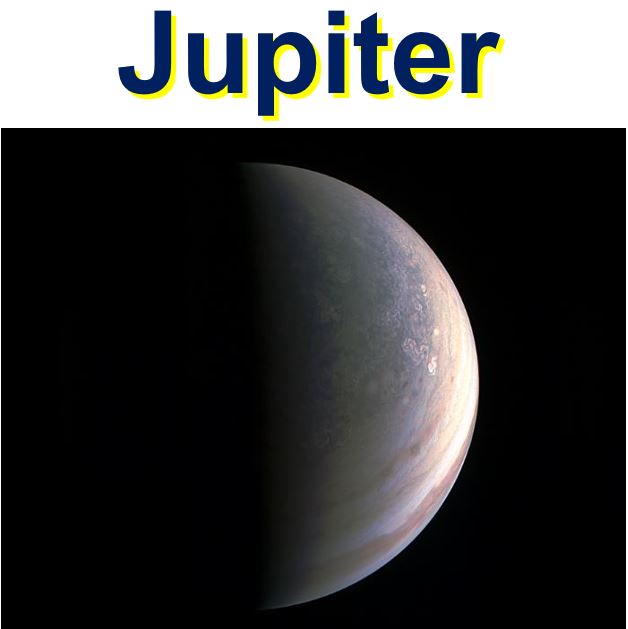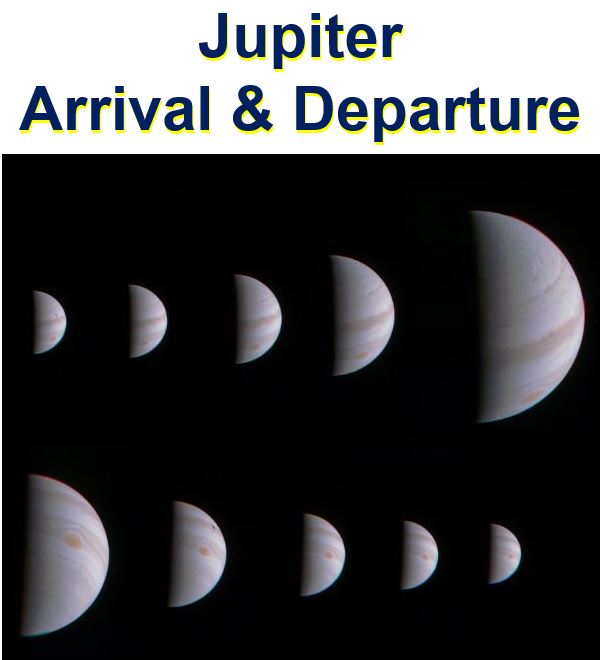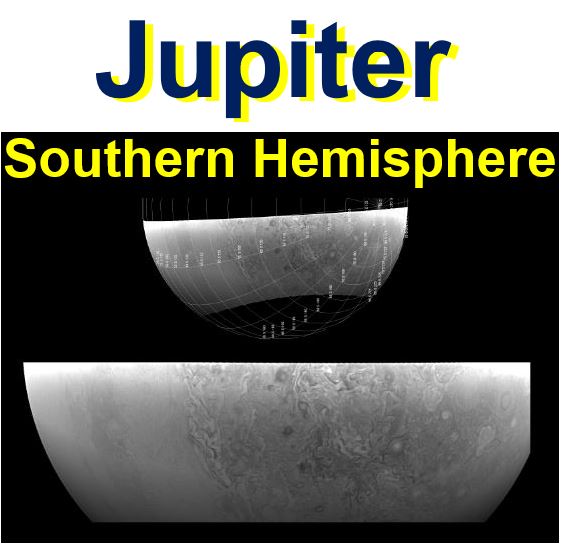Images of the north pole of Jupiter have been sent back from NASA’s Juno spacecraft – they are breathtaking and unique; there is nothing like the things we can see in them anywhere else in our solar system. The pictures, which came from Juno during its first flyby of the gas giant, the fifth planet from our Sun, with its instruments switched on, show weather activity and storm systems unlike anything we have so far detected on any of our solar system’s gas-giant planets.
Juno, which was launched from Cape Canaveral Air Force Station in August 2011, and entered orbit around Jupiter on 5th July 2016, successfully executed the first of thirty-six flybys on 27th August, when the probe came to within 2,500 miles (4,200 km) of Jupiter’s whirling clouds.
 An infrared view of Jupiter’s south pole revealing the planet’s southern aurora (southern lights). Such views are impossible from Earth. (Image: twitter.com/NASA)
An infrared view of Jupiter’s south pole revealing the planet’s southern aurora (southern lights). Such views are impossible from Earth. (Image: twitter.com/NASA)
Over 6 megabytes of Jupiter image data
The more than six megabytes of data that were collected during the 6-hour transit – from above the gas giant’s north pole to below its south pole – took thirty-six hours to download.
NASA scientists, who say their analysis of this initial data collection is ongoing, claim that some unique discoveries have already made themselves visible.
Scott Bolton, principal investigator of Juno from the Southwest Research Institute in San Antonio, Texas, said:
“First glimpse of Jupiter’s north pole, and it looks like nothing we have seen or imagined before .It’s bluer in color up there than other parts of the planet, and there are a lot of storms.”
“There is no sign of the latitudinal bands or zone and belts that we are used to – this image is hardly recognizable as Jupiter. We’re seeing signs that the clouds have shadows, possibly indicating that the clouds are at a higher altitude than other features.”
 The JunoCam instrument took this picture on 27th August, at a distance of 120,000 miles (195,000 km), about two hours before its closest approach to Jupiter’s swirling clouds. The poles are mottled with rotating storms of various sizes, like giant versions of the hurricanes we get on Earth. (Image: nasa.gov)
The JunoCam instrument took this picture on 27th August, at a distance of 120,000 miles (195,000 km), about two hours before its closest approach to Jupiter’s swirling clouds. The poles are mottled with rotating storms of various sizes, like giant versions of the hurricanes we get on Earth. (Image: nasa.gov)
There is one notable finding from these first-ever pictures of Jupiter’s two poles, which the JunoCam imager failed to see.
The largest gas giant is truly unique
Dr. Bolton said:
“Saturn has a hexagon at the north pole. There is nothing on Jupiter that anywhere near resembles that. The largest planet in our solar system is truly unique. We have 36 more flybys to study just how unique it really is.”
All of Juno’s eight science instruments were energized and gathered data during the flyby. JIRAM (Jovian Infrared Mapper), which the Italian Space Agency supplied, obtained some spectacular images of Jupiter at its northern and southern polar regions in infrared wavelengths.
Alberto Adriani, JIRAM co-researcher, who works at the Istituto di Astrofisica e Planetologia Spaziali in Rome, said:
“JIRAM is getting under Jupiter’s skin, giving us our first infrared close-ups of the planet. These first infrared views of Jupiter’s north and south poles are revealing warm and hot spots that have never been seen before.”
“And while we knew that the first-ever infrared views of Jupiter’s south pole could reveal the planet’s southern aurora, we were amazed to see it for the first time. No other instruments, both from Earth or space, have been able to see the southern aurora.”
“Now, with JIRAM, we see that it appears to be very bright and well-structured. The high level of detail in the images will tell us more about the aurora’s morphology and dynamics.”
 A montage of images spaced about 10 hours apart as Juno approached Jupiter and then left the gas giant. The small black spots visible in some of the photos are shadows of the large Galilean moons. (Image: nasa.gov/image)
A montage of images spaced about 10 hours apart as Juno approached Jupiter and then left the gas giant. The small black spots visible in some of the photos are shadows of the large Galilean moons. (Image: nasa.gov/image)
The mission’s Radio/Plasma Wave Experiment (Waves) recorded ghostly-sounding transmissions that emanated from above the planet.
We have known about these radio emission for over sixty years, but they had never been analyzed from a close vantage point – that is, until now.
Waves instrument co-investigator, Bill Kurth, from the University of Iowa, Iowa City, said:
“Jupiter is talking to us in a way only gas-giant worlds can. Waves detected the signature emissions of the energetic particles that generate the massive auroras which encircle Jupiter’s north pole. These emissions are the strongest in the solar system.”
“Now we are going to try to figure out where the electrons come from that are generating them.”
 A close-up view of Jupiter’s southern hemisphere, taken by the Juno spacecraft. This image was obtained by the JunoCam instrument with its red spectral filter when the probe was about 23,600 miles (38,000 km) above the clouds. The smaller image shows the same view with a latitude/longitude grid overlaid. (Image: nasa.gov/image-feature)
A close-up view of Jupiter’s southern hemisphere, taken by the Juno spacecraft. This image was obtained by the JunoCam instrument with its red spectral filter when the probe was about 23,600 miles (38,000 km) above the clouds. The smaller image shows the same view with a latitude/longitude grid overlaid. (Image: nasa.gov/image-feature)
Juno’s solar panels
Because of its operational distance from the Sun, the Juno probe is fitted with three solar panels measuring 9.8ft by 29ft (2.7m by 8.9m). Their total generation capability at Jupiter is of 486 W, declining to 420 W at the end of the mission due to radiation degradation.
Thanks to the significant advances in solar cell technology over the past few decades, Juno is able to use solar panels instead of RTGs.
Juno is the farthest solar-powered spacecraft we have ever sent out on a space exploration mission.
Sounds of space: Listen to #Jupiter’s auroras as heard by @NASAJuno https://t.co/PM84GMSP3Y pic.twitter.com/QCBGbjqewO
— NASA JPL (@NASAJPL) September 2, 2016
About Jupiter
Jupiter, the 5th planet from the Sun, is composed mainly of liquid and gaseous matter. It is the largest of our Solar System’s giant planets (the other three giants are Saturn, Uranus and Neptune). Its diameter at its equator is 142,984 km (88,846 miles).
Jupiter is the largest planet in the Solar System. In fact, its mass is 2.5 times the combined mass of all the other planets that orbit the Sun.
Although it is considerably larger than Earth – 1,321 times its volume – it is only 318 times Earth’s mass. This means that Earth is much denser.
Its radius is about one-tenth that of the Sun, while its mass is 0.0001 times the mass of the Sun, which makes the densities of the two bodies more or less the same.
Jupiter has many moons – a total of sixty-seven natural satellites, of which fifty-one are less than 10km in diameter. Its four largest moons, known as the Galilean moons, are called Callisto, Ganymede, Europa and Io. They are visible from earth with binoculars.
Video – Jupiter’s glow in infrared light
This NASA Jet Propulsion Laboratory video shows Jupiter’s glow in infrared light, captured by Juno’s Jovian Infrared Auroral Mapper (JIRAM) instrument as the probe approached the gas giant on 27th August.
